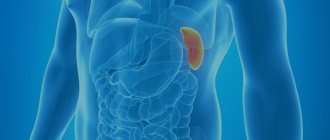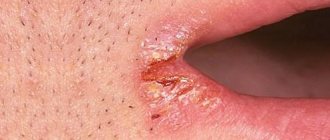Author:
Chekaldina Elena Vladimirovna otorhinolaryngologist, Ph.D.
Quick Transition Treatment of Peritonsillar Abscess
A peritonsillar abscess (PTA) is a collection of pus between the tonsil capsule and the pharyngeal muscles.
The anterior PTA is most often diagnosed; it is localized between the upper pole of the tonsil and the anterior palatine arch. They also distinguish between the posterior PTA - between the tonsil and the posterior palatine arch, the lower PTA - at the lower pole of the tonsil, the external PTA - outside the tonsil.
Peritonsillitis is an infectious inflammatory disease of the tissue surrounding the palatine tonsil, without the formation of an abscess (cavity with pus).
Paratonsillitis or PTA is usually preceded by acute tonsillopharyngitis, but in some cases the disease can develop without a previous infection of the pharynx, which is associated with blockage of the salivary glands.
Peritonsillar abscess is the most common infection of the deep tissues of the neck in children and adolescents, accounting for at least 50% of cases. The annual incidence of PTA is 30-40 cases per 100,000 people aged 5 to 59 years.
The main causative agents of PTA are Streptococcus pyogenes (beta-hemolytic streptococcus group A, GABHS), Streptococcus anginosus (angios streptococcus), Staphylococcus aureus (Staphylococcus aureus, including methicillin-resistant strains - MRSA) and respiratory anaerobes (including Fusobacteria, Prevotella and Veillon).
How to treat peritonsillar abscess?
Treatment is carried out in two stages:
- Surgical.
- Conservative.
First of all, it is necessary to evacuate the pus from the peritonsillar space.
This can be done in the following ways:
A) Tonsillectomy - removal of the tonsils.
B) Puncture (puncture) and aspiration.
B) Opening (incision) and dividing the paratonsillar space.
After draining the pus, the patient should receive antibacterial and anti-inflammatory therapy.
Diagnostics
In the vast majority of cases, the diagnosis of PTA is made clinically, based on the results of pharyngoscopy (examination of the pharynx). It is confirmed by obtaining purulent discharge during drainage of the abscess or by instrumental studies (most often ultrasound).
Pharyngoscopy reveals a swollen and/or fluctuating tonsil with deviation of the uvula in the direction opposite to the lesion, hyperemia (redness) and swelling of the soft palate. In some cases, there is plaque or liquid discharge in the palatine tonsil. There is an increase and tenderness of the cervical and submandibular lymph nodes.
Bilateral PTA is extremely rare and its diagnosis is more difficult due to the lack of asymmetry in the pharynx, as well as the rarely present spasm of the masticatory muscles.
Laboratory tests are not required to make a diagnosis; they are additionally prescribed to determine the severity of the disease and select a treatment method.
Laboratory tests may include:
- general blood test with leukocyte formula;
- study of electrolytes (potassium, sodium, chlorine) for signs of dehydration;
- strepta test to exclude GABHS;
- culture for aerobic and anaerobic bacteria if the abscess was drained (culture is recommended only for complicated PTA, recurrent PTA, or in patients with immunodeficiency conditions).
Instrumental examination methods - ultrasound, computed tomography, lateral neck x-ray, magnetic resonance imaging or angiography - are not necessary and are performed to exclude other diseases if the diagnosis of PTA is not obvious.
Differential diagnosis
Severe course of acute tonsillopharyngitis . Frequent pathogens are Epstein-Barr virus, herpes simplex virus, Coxsackie virus (herpangina), adenovirus, diphtheria, GABHS, gonorrhea. It manifests itself as bilateral swelling in the throat, hyperemia, and plaque may be present on the tonsils.
Epiglottitis . An inflammatory disease of the epiglottis, usually caused by Haemophilus influenzae. More common in young children who have not been vaccinated against Haemophilus influenzae type b. Progresses faster than PTA. Manifested by sore throat, drooling, difficulty swallowing, respiratory failure.
Retropharyngeal abscess (retropharyngeal abscess) . Purulent inflammation of the lymph nodes and tissue of the retropharyngeal space. Most often observed in children aged 2 to 4 years. During pharyngoscopy, minimal changes are noted. Main complaints: stiff neck, pain on movement, especially when extending the neck (as opposed to the increased pain on flexion seen with meningitis), swelling and tenderness of the neck, chest pain, difficulty swallowing, drooling, muffled voice, spasm of the masticatory muscles ( present in only 20% of cases).
Types of disease
The inflammatory process can occur on the left or right in the pharynx. Such inflammation is called one-sided - respectively, a left-sided or right-sided abscess. If inflammation occurs on both the left and right at the same time, this is a bilateral type of inflammation.
If we take the location of the purulent “pocket” as the basis for the classification, the following types of disease are distinguished:
- anterior - the most common type of diagnosis; the tissues above the tonsils become inflamed;
- posterior, when purulent inflammation occurs between the posterior palatine arch and the tonsil; such inflammation can spread to the larynx;
- lower, when inflammation is located at the lower pole of the tonsil, while the anterior palatine arch moves forward and downward;
- external (lateral) - a less common, but most severe type, in which a suppurating cavity appears between the edge of the tonsil and the wall of the pharynx. With this form of the disease, pus can break into healthy tissue in the neck.
results
A method has been developed to improve the technique of percutaneous drainage with a stylet catheter under ultrasound guidance by infiltrating the interloop tissue (intestinal mesentery, omentum) with an anesthetic solution. Injecting fluid into the adjacent tissue allows you to increase the space for acoustic access, displacing the intestinal wall, and outline the drainage path, bypassing large vessels and the intestinal wall and thereby avoiding their damage.
Drainage was performed in 103 patients. The duration of the manipulation was 20±8.2 minutes. In 97 of 103 patients, one intervention was required to adequately drain the cavity. In 6 cases, additional drainage was performed on days 3–11 due to the insufficient effectiveness of primary drainage. In 3 patients, repeated drainage was performed on the 60th day after surgery due to failure of the intestinal anastomosis and failure to close the internal fistula. Cure occurred in 101 (98%) patients within 10–73 days. Mortality rate was 1.9% ( n
=2). A 53-year-old patient died from pulmonary embolism 2 months after undergoing surgery (laparoscopic gastrectomy for stomach cancer, gastric bleeding). The second patient, 74 years old, died due to adhesive intestinal obstruction, which required surgical intervention - laparotomy, adhesiolysis. The course of the postoperative period was complicated by multiple intestinal fistulas, abdominal abscesses, and suppuration of the postoperative wound. In none of the cases was repeated open drainage of the abscess required. In 2 cases of the formation of external intestinal fistulas in the postoperative period, obstructive intestinal resection was required.
The results of dynamic ultrasound and fistulography were analyzed. It was revealed that in 67% the data coincided, which makes it possible to abandon fistulography at the final stage of treatment if the clinical course is positive. Therefore, only ultrasound is sufficient to assess the residual cavity. In addition, ultrasound-guided drainage is an effective independent method of treating abscesses associated with hollow organs without additional interventions to close the fistula.
Causes of the disease
Peritonsillitis occurs when pathogens enter the tissues around the tonsils.
The causative agents of the disease are streptococci, staphylococci, and fungi.
How do pathogenic microorganisms get into the paramygdaloid tissue? There may be several reasons for the start of the inflammatory process:
- untreated tonsillitis, when bacteria from the tonsils penetrate into nearby tissues;
- exacerbation of chronic tonsillitis, when pathogenic microflora also penetrates from the tonsils;
- dental diseases - for example, caries (infection comes from the oral cavity), although it is not necessary that the tonsils themselves become inflamed;
- injury to the tissue around the tonsils, during which infection occurs;
- infection through the bloodstream;
- chronic accumulations of infection in the body (for example, chronic sinusitis);
- diabetes;
- reduced immunity;
- smoking.
Typically, purulent inflammation acts as a complication of chronic or acute tonsillitis (tonsillitis) - this is the most common cause of the disease.
Causes and course of the disease
The development of a paratonsillar abscess occurs in several stages.
First, paratonsillitis is formed, then a phlegmonous (purulent diffuse focus) process and abscess formation follows, a process of spontaneous emptying of pus into the space near the tonsils or into the pharyngeal cavity occurs. The cause of the development of this disease may be suppuration of the tonsil during tonsillitis or exacerbation of chronic tonsillitis. In addition, a peritonsillar abscess can occur due to the spread of a purulent process that has developed in the gums due to dental caries, as well as when it is difficult for the eighth tooth to erupt in the lower jaw. Depending on the location of the lesion, by analogy with paratonsillitis, the abscess in location to the palatine tonsil can be anterior, posterior, inferior and external.
Diet
Diet for sore throat
- Efficacy: therapeutic effect after 3-5 days
- Lead time: 5-7 days
- Cost of products: 1500-1600 rubles. in Week
Diet 0 table
- Efficacy: therapeutic effect after 21 days
- Terms: 3-5 months
- Cost of products: 1200-1300 rubles. in Week
In the edematous/infiltrative stages, a diet for angina is prescribed. After opening a paratonsillar abscess, Diet 0 table or in cases of abscessonsillectomy - Diet after tonsillectomy .
Indications for opening an abscess
The possibility of developing this kind of complications can be assumed if the following symptoms are present:
- tonsillitis, the duration of which exceeds 5-6 days: during this time an abscess may form;
- severe, severe pain in the throat that is felt when swallowing or moving the head;
- temperature increase over 39 degrees;
- significant enlargement of one or two tonsils;
- signs of intoxication and fever (weakness, malaise, muscle pain, apathy and drowsiness);
- enlarged lymph nodes;
- increased heart rate and breathing.
The development of an abscess, which is accompanied by such symptoms, is a direct indication for opening the abscess.
Usually the operation is performed 4-5 days from the onset of the inflammatory process - by this time the abscess is already fully formed. To check the readiness of the cavity for removal, the doctor may prescribe a diagnostic puncture - puncturing the cavity with a thick needle in the place that protrudes the most above the tonsil. The progress of the procedure is most often monitored by endoscopic or ultrasound monitoring. If pus is found in the cavity of the syringe used for puncture, it means that an abscess has formed and is ready for removal.
The autopsy is performed on an outpatient basis, that is, to perform it, the patient does not need to go to the ENT department of a medical institution.
How is an abscess removed?
A few days before the planned surgery, the patient needs to start taking antibiotics.
Before the autopsy begins, the patient is given an anesthetic for local anesthesia. In the place where the wall of the pharynx protrudes most and has the smallest thickness, the doctor makes an incision into the purulent formation. Its depth does not exceed 10-15 millimeters - this way it is possible to prevent damage to adjacent vessels and nerves. Using a special suction, the surgeon removes purulent contents from the cavity, after which he inserts a blunt instrument into the incision and destroys the partitions of the cavity from the inside to improve the outflow of pus. Next, an antiseptic is injected into the cavity, the doctor stops the bleeding and sutures the edges of the wound.
If during the process it is discovered that the pus does not have a clear localization, but has spread between the fascia of the neck, the surgeon decides to take the necessary therapeutic measures. The scope of the operation is expanding, since this condition is deadly for the person being operated on. If necessary, a drainage tube can be inserted into the patient through incisions in the neck. Each specific situation requires different surgical procedures.
List of sources
- Palchun V.T., Kryukov A.I. Otorhinolaryngology: A guide for doctors. M., 2001: 257-315.
- Taukeleva S.A. Peritonsillitis. Almaty. 1997. pp. 38-43.
- Izvin A.I. Clinical lectures on otorhinolaryngology, Tyumen, 2004.
- Palchun V.T., Luchikhin L.A., Kryukov A.I. Inflammatory diseases of the pharynx. M.: “GEOTAR-media”, 2007: 288 p.
- Kiselev A.S. Towards the diagnosis of acute purulent inflammation of the para- and retropharyngeal spaces // News of otorhinolaryngology and logopathology. 1998. No. 4. pp. 80–82.
Clinical picture
There is pain in the throat, which increases with swallowing, turning the head and coughing.
The patient experiences difficulty opening his mouth, which is accompanied by severe pain. Trismus (inability to fully open the mouth) of the masticatory muscles is noted. The patient is forced to refuse to eat and drink, the pain interferes with his normal sleep. Body temperature is elevated, patients complain of weakness and malaise. When performing pharyngoscopy, hyperemia (pronounced redness) of the mucous membrane and infiltration of one half of the soft palate and palatine arches on the affected side are determined.
The palatine tonsil is slightly shifted to the healthy side and is tense. The lymph nodes located under the jaw and on the neck become somewhat swollen. Due to the fact that the soft palate is almost motionless, the voice becomes nasal. The most common are peri-almond abscesses with anterior and upper anterior localization.










